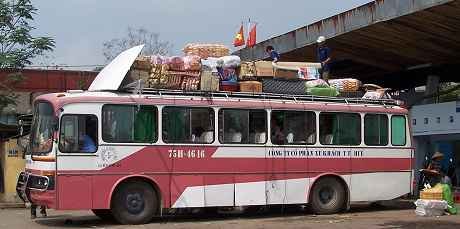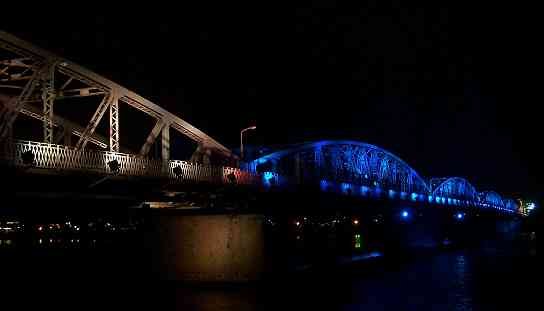Hue |
| Ho Chi Minh City | Home | Demilitarised Zone | HoiAn |
Introduction to Hue, Vietnam
Hue is located about halfway up Vietnam on the Perfume River, and was once the capital of the southern part of Vietnam. Must see things in Hue are the Imperial Enclosure and Forbidden Purple City within the Citadel, and just upstream from Hue are the Pagodas and Imperial Tombs.
| Tinh Gia Vien Restaurant |
 A sampan on the Perfume River. |
Fast Facts about Hue
|
 |
Hue central marketThe photograph on the left shows piles of sugar canes for sale in the central market in Hue. This market, along with most other markets in Vietnam, is a fascinating place to visit. It is also the best place to buy the conical hats worn by locals and tourists alike. These hats really are light and comfortable to wear, and cost so little. Hue specialises in "poem hats", these have pictures sandwiched between the two layers of dried leaves that can be seen when held up to the light. |
 |
Pole carriersOn the left a lady is loading up her two baskets which she will carry on a pole over her shoulder. Everything is carried this way, and the carriers can manage quite heavy loads. They develop a callus on their shoulder where the bamboo pole rests, and when fully loaded have a smooth, rythmic walk. If you are frightened to cross the road, then cross with a pole carrier. It will amuse them and you will get safely across the road. |
 |
The bus on the left was in the market bus station. Buses are generally overloaded in this manner. Throughout Vietnam the safety regulations are less severe than might be expected. This can be scary, fun, liberating, exciting, or just dangerous - it all depends on your frame of mind and what you are doing at the time. |
 |
 |
A street scene just outside the market. |
 |
Trang Tien bridge at night, left, and during the day, below. Motorbikes, scooters and cyclos are the common form of transport. |
 |
|
An alleyway near the Citadel. It was during Tet when we visited Vietnam this time, and everywhere there were banners wishing people a Happy new Year. |
 |
Starting business in VietnamAlthough Vietnam is a communist country small businesses are everywhere, and usually they are thriving. The easiest way to start up a business is to choose one of the three options on the right. Mobile bicycle repairsThe cheapest is to become a mobile bicycle repair man. Nowadays all you need is a pump, a basin or water and rubber sealant. You can see these guys at almost every busy intersection. They do the work while the customer waits. Just after reunification, when money was tight, few of them could afford a plastic basin for their water, so they used an upturned combat helmet - which were abundant at the time. |
 |
On the right is the pole carrier. All you need are two baskets, buckets or containers of some sort, twine, and a stout bamboo pole. then you can either simply transport goods from one location to the next, or buy or make goods for sale and sell them at the roadside. Fresh fruit and coconuts are popular, as is tea or noodle soup. Many of the noodle shops you see today started off in this way. Firstly with just the pole carrier setting up at the side of the road and the customers eating standing up or in their own premises. Then as buisness prospered a plastic table and four low stools were added. This meant mobility was lost, but more customers could be served and a regular clientele built up. Next step was to get more tables and chairs and perhaps even the luxury of an awning to protect from rain and sun. By this time the pole carrier is no longer a pole carrier, but must use a cart of some sort. The next step is the biggest, and that is to move to a building of some sort. |
 |
Cycle driver The cyclo driver, on the right may or may not own his cyclo. In some cities only registered residents can own and operate cyclos. This means that others must rent the cyclo by the day, and unless these drivers attract tourists they do not make enough money. Cyclo owners are usually in a better position. Usually the cyclo will work almost 24 hours a day being driven by different family members round the clock. Just occasionally will the cyclo be owned solely, and in these cases the cyclo may be the driver's home as well as his means of earning a living. Some cyclo drivers will try to cheat you, others will be nice and very informative. You must bargain for the ride, but make sure that you agree the price beforehand, and also make sure you are both talking about the same currency! Some cyclo drivers do not like to pull up outside the major hotels. I think this may be because they are unregistered, or the doormen expect a cut of the fare or something. If you have no luggage do try to be understanding about this. Riding a cyclo for the first time in busy traffic can be quite an experience, remember if you want to stay attached to your arms keep them by your sides! |
 |